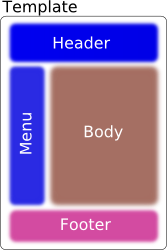

After installing and learning some of Tiles concepts, it is time to create some pages. Here you will find the steps to create reusable Tiles pieces and complete pages.
Let's take the classic layout page structure:

Create a JSP page that acts as this layout and place it under /layouts/classic.jsp file.
<%@ taglib uri="http://tiles.apache.org/tags-tiles" prefix="tiles" %>
<html>
<head>
<title><tiles:getAsString name="title"/></title>
</head>
<body>
<table>
<tr>
<td colspan="2">
<tiles:insertAttribute name="header" />
</td>
</tr>
<tr>
<td>
<tiles:insertAttribute name="menu" />
</td>
<td>
<tiles:insertAttribute name="body" />
</td>
</tr>
<tr>
<td colspan="2">
<tiles:insertAttribute name="footer" />
</td>
</tr>
</table>
</body>
</html>
This template has five attributes: title (of string type), header, menu, body and footer.
In this phase, you have to create four JSP pages, that will take place of header, menu, body and footer attributes in the previously created template.
You can put everything you want in this pages, they are just a test.
Supposing that you configured Tiles, in web.xml, to startup using the TilesServlet, you need to specify what will be the files containing the Tiles definitions to load:
<servlet>
<servlet-name>tiles</servlet-name>
<servlet-class>org.apache.tiles.servlet.startup.TilesServlet</servlet-class>
<init-param>
<param-name>org.apache.tiles.impl.BasicTilesContainer.DEFINITIONS_CONFIG</param-name>
<param-value>/WEB-INF/tiles-defs.xml</param-value>
</init-param>
<load-on-startup>2</load-on-startup>
</servlet>
Create the /WEB-INF/tiles-defs.xml file:
<?xml version="1.0" encoding="ISO-8859-1" ?>
<!DOCTYPE tiles-definitions PUBLIC
"-//Apache Software Foundation//DTD Tiles Configuration 2.1//EN"
"http://tiles.apache.org/dtds/tiles-config_2_1.dtd">
<tiles-definitions>
<definition name="myapp.homepage" template="/layouts/classic.jsp">
<put-attribute name="title" value="Tiles tutorial homepage" />
<put-attribute name="header" value="/tiles/banner.jsp" />
<put-attribute name="menu" value="/tiles/common_menu.jsp" />
<put-attribute name="body" value="/tiles/home_body.jsp" />
<put-attribute name="footer" value="/tiles/credits.jsp" />
</definition>
</tiles-definitions>
After creating the definition, you can render it:
<%@ taglib uri="http://tiles.apache.org/tags-tiles" prefix="tiles" %> <tiles:insertDefinition name="myapp.homepage" />
TilesContainer container = TilesAccess.getContainer(
request.getSession().getServletContext());
container.render("myapp.homepage", request, response);